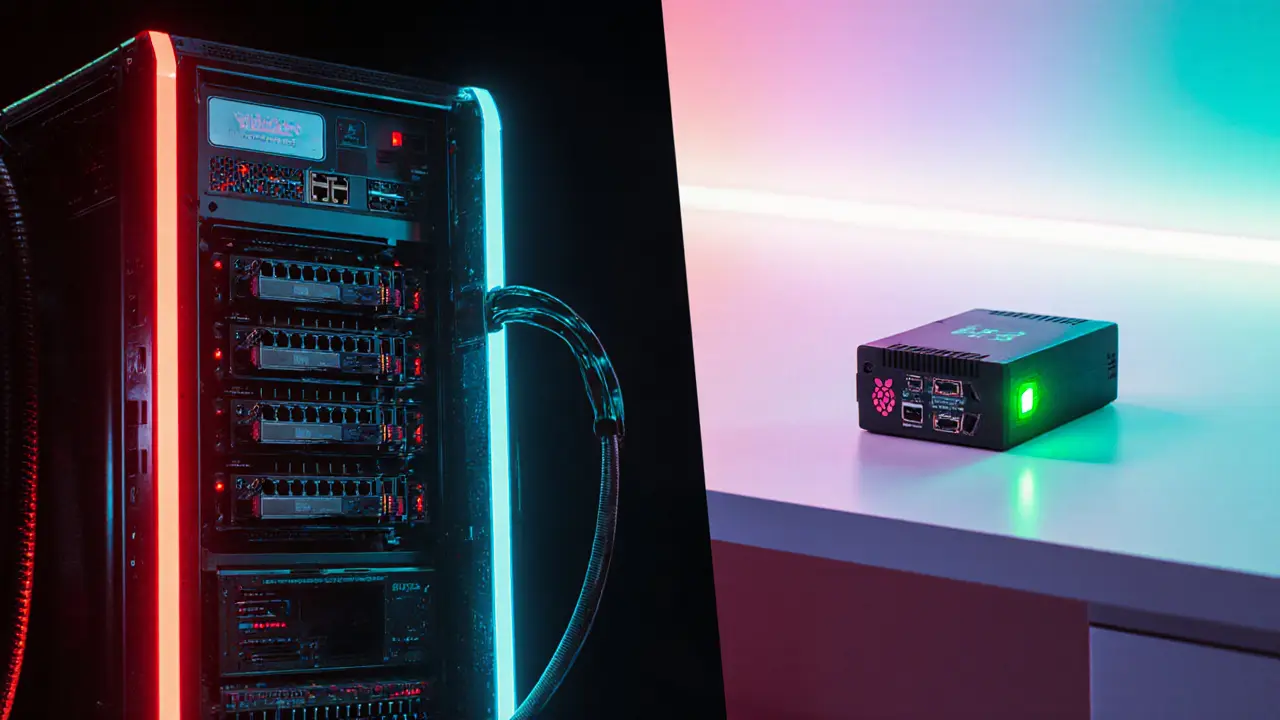Validator vs Full Node Cost Calculator
Validator Node Settings
Full Node Settings
Cost Comparison
- Hardware: $0.00
- Electricity: $0.00
- Storage: $0.00
Running a full node is free after initial setup costs
When you hear the words “validator” and “full node” tossed around in blockchain forums, you might wonder whether they’re two names for the same thing or completely different roles. The short answer: they’re distinct pieces of the network puzzle, each with its own job, hardware needs, and risk profile. This guide walks you through every major difference, so you can decide which (or both) fits your goals.
What a Validator Node Actually Is
Validator node is a specialized participant in Proof‑of‑Stake (PoS) blockchains that actively takes part in the consensus process. It proposes new blocks, votes on other validators’ blocks, and earns staking rewards in exchange for doing so. Validators must lock up a network‑specific token as collateral - 32 ETH for Ethereum, hundreds of thousands of ADA for Cardano, or tens of thousands of ATOM for Cosmos. If a validator behaves badly, a portion of that stake can be slashed, meaning they lose money directly.
Because security in PoS hinges on economic stake, validators are the backbone of network safety. They keep the ledger honest by signing attestations that tell the rest of the chain whether a block is valid. In return, they share in newly minted coins and transaction fees.
What a Full Node Does
Full node is a complete copy of the blockchain that continuously synchronizes with peers to verify every transaction and block against consensus rules. Unlike validators, full nodes do not take part in block production and they do not need to stake any tokens. Their primary purpose is to provide a trustworthy data source for wallets, explorers, and other applications, ensuring anyone can independently check the state of the chain.
Full nodes act as the “read‑only” layer of the network. They answer RPC queries, serve fee‑estimates, and help decentralize verification by allowing users to run their own trusted copy of the ledger.
Hardware and Cost Comparison
Running a validator is a serious hardware commitment. Ethereum’s consensus specifications (v1.2.0, Aug 2023) recommend a minimum of 16 GB RAM, a 1 TB SSD, and a quad‑core CPU. Solana pushes that even higher: 128 GB RAM, 2 TB NVMe, and 10 Gbps network connectivity. On top of the hardware, you need to lock up capital - roughly $51 k for 32 ETH at October 2023 prices - and cover electricity and cooling costs that can exceed $500 per month for high‑performance setups.
Full nodes are far lighter. A Bitcoin Core full node needs about 500 GB of storage (growing by ~1‑2 GB per day), 2 GB RAM, and any broadband connection. Many hobbyists run a Bitcoin node on a Raspberry Pi 4 with a 2 TB external drive for under $200 total cost and about $3/month electricity.
| Aspect | Validator Node | Full Node |
|---|---|---|
| Primary Role | Participates in consensus, creates/validates blocks | Stores full ledger, verifies blocks, answers queries |
| Staking Requirement | Mandatory (e.g., 32 ETH, 500k ADA) | None |
| Hardware Minimum | 16 GB RAM, 1 TB SSD, 4‑core CPU | 2 GB RAM, 500 GB storage, standard CPU |
| Revenue | Staking rewards (3‑8 % APY depending on chain) | No direct revenue |
| Risk | Slashing, hardware failure, volatility | Only operational cost; no financial loss |
| Uptime Expectation | >99.9 % for rewards | >99.5 % typical |

Setup Complexity and Ongoing Maintenance
Launching a validator can take a full day for seasoned operators. You need to generate keys, deposit the stake, install a client (e.g., Prysm, Lighthouse), configure monitoring dashboards, and set up alerts. After the initial launch, weekly maintenance involves checking missed attestations, updating client software, and ensuring network latency stays low.
Full node installation is considerably simpler. For Bitcoin, you download the Core client, let it sync (which can take 24‑72 hours on consumer hardware), and you’re ready. Once synced, the node mostly runs in the background, with occasional storage upgrades as the chain grows.
Performance Impact on the Network
Validators directly influence throughput. Solana validators can push 65 000 TPS under optimal conditions, while Ethereum validators collectively handle about 15‑30 TPS. Their speed and reliability affect block finality and user experience.
Full nodes, meanwhile, affect how quickly users can retrieve data. A well‑connected Bitcoin full node can serve a new block to peers within seconds, keeping the network’s gossip layer healthy. However, they do not affect the chain’s transaction capacity.
Economic Incentives and Risks
Staking rewards are the main lure for validators. Ethereum validators earn roughly 3‑5 % APY before costs, and Solana validators see 6‑8 % APY. But the upside comes with slashing risk: a validator that signs conflicting blocks can lose up to 100 % of its stake, and even minor misbehaviour can cost 0.5 %.
Full nodes earn nothing directly, but they provide intangible value: sovereignty, decentralization, and compliance. Institutions run full nodes to avoid reliance on third‑party APIs, which can be censored or compromised.

Security and Decentralization Considerations
Because validators hold the economic weight of a PoS chain, concentration can be dangerous. In Q3 2023, three entities operated about 31.5 % of Ethereum’s validator set, creating a potential single point of failure. Decentralization advocates therefore encourage running independent validators or using decentralized staking services.
Full nodes are inherently decentralized. Bitcoin’s node distribution is geographically diverse, with no single provider controlling a majority of the network. Running a personal full node ensures you can verify the chain without trusting anyone else.
Future Trends for Validators and Full Nodes
Upcoming upgrades aim to lower entry barriers. Ethereum’s Dencun upgrade (Q1 2024) should cut validator hardware requirements by up to 40 %. Meanwhile, Distributed Validator Technology (DVT) lets a validator’s stake be spread across several physical machines, reducing the impact of a single hardware failure.
Full nodes are also evolving. Bitcoin Core v25.0 is testing Utreexo, a cryptographic accumulator that could shrink storage from 500 GB down to around 1 GB while preserving verification security, making full node operation feasible on smartphones.
Choosing the Right Path for You
If you’re looking for direct crypto income and have capital to lock up, a validator might be the right fit - provided you’re ready for the technical grind and risk of slashing. If you value independence, want to support network health without financial exposure, running a full node is a rewarding hobby that also strengthens decentralization.
Many operators combine both: they stake on a validator service for passive income and run a personal full node to double‑check the chain’s state. This hybrid approach gives the best of both worlds - earnings plus verification.
Do I need to be a developer to run a validator?
While you don’t need to write code daily, you should understand networking, Linux system administration, and the basics of the consensus algorithm you’re using. Most guides assume a comfortable level with command‑line tools.
Can I run a validator without owning the required stake?
Yes - many services offer pooled staking or “validator‑as‑a‑service.” You contribute a smaller amount, and the provider runs the hardware for you, but you share rewards and fees.
How much storage does a Bitcoin full node need today?
Around 500 GB and growing about 1‑2 GB per day. Using compression tools or upcoming Utreexo could dramatically lower that number.
What is slashing and how can I avoid it?
Slashing is the penalty for misbehaving - e.g., double‑signing or staying offline too long. To avoid it, keep your node online 99.9 %+, monitor alerts, and update client software promptly.
Do full nodes improve network security?
Yes. They give every user the ability to verify the chain independently, preventing any single party from feeding false data.

Stephen Rees
October 22, 2025 AT 09:36When we look at the architecture of a blockchain, the validator emerges not merely as a node, but as a guardian of truth, a sentinel standing at the edge of consensus.
It is tempting to assume that its role is purely technical, yet beneath the surface lies a deeper question about power and control.
Who decides which validators are trustworthy? Who watches the watchers?
The answer, of course, is hidden behind layers of code, stake, and reputation, but the veil is thin enough for the curious to peer through.
Every time a validator signs a block, it places a piece of its own capital at risk, a stake that can be taken away if misbehaviour is detected.
This mechanism is supposed to align incentives, but it also creates a subtle coercion, a pressure that can be felt even when the node is operating flawlessly.
Consider the scenario where a validator is offline for a brief period; the slashing penalties may feel like a whisper of control, nudging the operator toward constant vigilance.
Such vigilance, while technically sound, may also serve as a quiet reminder that the network's health is, in part, dependent on the financial well‑being of a few.
It is this intersection of economics and security that fuels the paranoia of those who watch from the sidelines, wondering whether the concentration of stake could one day become a point of failure.
The hardware requirements, too, act as a barrier, ensuring that only those with sufficient resources can participate, further tightening the circle.
Yet, the promise of decentralization persists, a promise that is both aspirational and fragile.
In the end, the validator is a mirror reflecting both the ambition of a decentralized future and the realities of human incentive.
It stands as a reminder that technology cannot escape the politics of power, even when it claims to be trustless.
We must remain vigilant, not only in monitoring uptime and performance but also in questioning who benefits when the ledger expands.
Only through such scrutiny can we hope to preserve the ideals that first inspired the blockchain movement.
Katheline Coleman
October 31, 2025 AT 21:36Thank you for the comprehensive overview; the distinction between validator nodes and full nodes is indeed pivotal for anyone considering participation in a proof‑of‑stake network.
Allow me to add that, from an operational standpoint, the reliability of network connectivity often proves as critical as the hardware specifications.
Ensuring a stable, low‑latency internet connection can prevent missed attestations, which otherwise might lead to reduced rewards.
Furthermore, regular monitoring of client software versions is essential to maintain compatibility with network upgrades.
I appreciate the mention of upcoming upgrades such as Dencun, which should lower entry barriers for prospective validators.
Amy Kember
November 10, 2025 AT 09:36Full nodes are cheap to run.
Scott McCalman
November 19, 2025 AT 21:36Whoa, this article just turned my brain into a fireworks display! 🚀💥 Validators are like the rockstars of the blockchain stage, always on tour and demanding a VIP backstage pass made of SSDs and RAM.
If you miss a single beat, the crowd (a.k.a. the network) boos you, and you get slapped with slashing – it’s drama central! 😱
Tiffany Amspacher
November 29, 2025 AT 09:36Honestly, reading about validator hardware feels like listening to a sci‑fi monologue about a spaceship that needs a whole power plant to take off.
Meanwhile, I can sit on my couch, plug a Raspberry Pi into my TV, and be part of the blockchain universe. Talk about low‑key rebellion.
Jessica Pence
December 8, 2025 AT 21:36Hey folks, just wanted to point out that if you're thinking about running a validator on a budget, consider using a cloud provider that offers spot instances – you can save a lot on the monthly electricity bill.
Also, make sure you set up automated backups of your keystore; I once tripped over my cat and lost my USB drive, and let me tell you, re‑staking after that was a real pain.